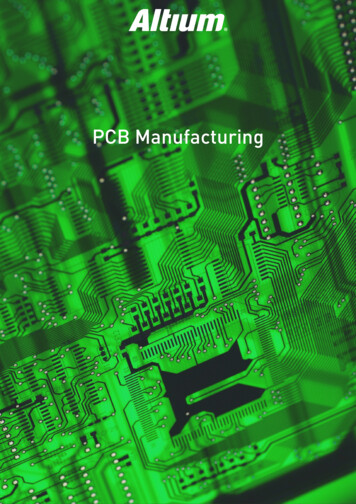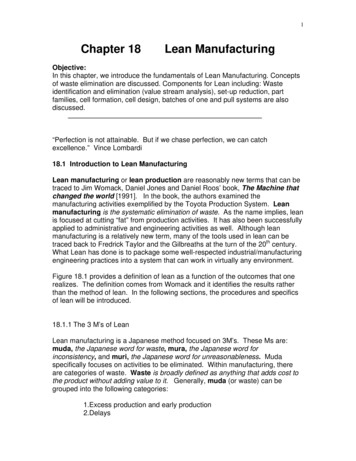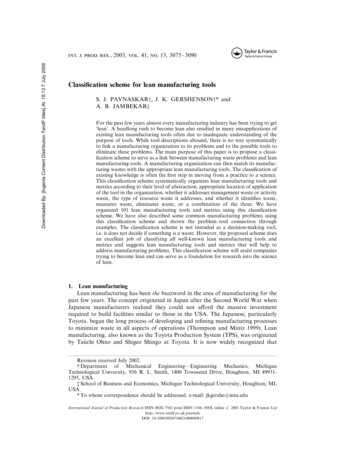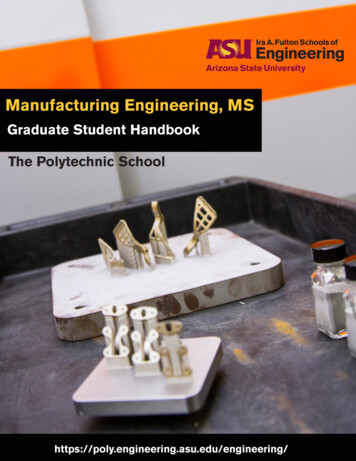
Transcription
&ManufacturingThe dawn of 5G technology is hereAre you ready for its unprecedentedpossibilities?1
CO NTE NTS3 Abstract17 This is the factory of the future5 What’s possible inmanufacturing with 5G?18 Preparing for 5G5Addressing Wi-Fi Capacity Limitations620 Reference sourcesIntelligent infrastructure8Augmented and virtual reality10Metrology/non-contact metrologyand video as a sensor11Autonomous-guided vehicles13Digital twin technology15Cost savings16Global integration19 Conclusions2
Manufacturing is poisedto begin experiencingsignificant benefits from 5GUnleash the full potential for your business5G, the fifth generation of cellular wireless technology, is poised to begin helping transformthe way the manufacturing industry operates. Through unprecedented speed, low latency,and bandwidth capacity, 5G using millimeter wave spectrum (5G ) can enable manufacturersdo more with the mega expansion of the Internet of Things (IoT), as well as collect more data,and compute more information faster to make better business decisions. It can also be acatalyst for your own innovation—both in the creation and quality of products, and in howthese products are delivered into the supply chain.3
Because manufacturing plays such a key role in in the global economy, every manufacturerhas the potential to impact companies in other industries, such as transportation, retail,healthcare, and many others. Since 5G will eventually help make it possible for companiesto adopt new and emerging technologies – including advanced robotics, vision systems,augmented reality (AR), and artificial intelligence (AI), it can help you to achieve enhancedefficiency and reliability to manufacture the products your partners, customers, and clientsdepend on.Massive deviceconnectivityThe 5G revolution will bring:Ultra lowlatencyData-driveninsightsEnhanced capacity andultra-high speeds4
What’s possible inmanufacturing with 5G?Of the many benefits, let’s focus on 8.Addressing Wi-Fi Capacity LimitationsFrom IoT and numerous other sources, you get data. Lots of data. This is great for the digitally transformingfactory, however, the data generated and the increased number of computations per microsecond challengesthe limits of what Wi-Fi was designed for.In order for the factory to adopt a digital transformation strategy, it’s necessary for the network that supportsit to keep pace with the technology that depends on it. The technologies of Network Edge Computing (NEC)and Multi-access Edge Computing (MEC) offer the interim step to 5G and address Wi-Fi capacity limitations thatinhibit manufacturers from optimizing operations, addressing workforce challenges, and providing more reliableservice to customers and the supply chain.5
Intelligent infrastructureAs manufacturers adopt an intelligent infrastructure—one that uses machine learning, prediction, analysis, andself-correction to operate—5G will support smarter integration and analysis of the data that’s generated bysensors. With so many interconnected technologies and endpoints (including robotics, mobility, and field-relatedapplications), you need highly reliable—and highly secure—compute power to process the large blocks of data.5G will help provide the highly secure foundation to efficiently move data out of corporate silos while alsohelping to ensure it stays safely within the walls of the facility. This goes beyond the mega expansion of IoTand into implementing smarter integration and analysis of data that’s generated by sensors. With so manyinterconnected technologies that are dependent upon these and other endpoints - including that generatedthrough robotics, mobility, and field-related applications, an increased level of reliability for the large blocks ofdata that must be transferred is required. 5G will ultimately provide the power and consistency needed for theintelligent infrastructure to breathe a new level of life into the possibilities manufacturers can explore to producenew products, services, and realize greater operational efficiencies.Source: AT&T Intelligent Business Report - 6
“The pace of technologyinnovation is so high, with somany advances—cloud, IoT, AR/VR,software-defined networking—that manufacturers are strugglingwith how to bring all of ittogether.”DAVID VANDORSELAERAVP Industry Solutions- Manufacturing andTransportation, AT&TBusiness7
Augmented and virtual realityFor the successful adoption and sustainability ofOther uses for these technologies in manufacturingaugmented reality (AR) and virtual reality (VR), whichinclude:is also known as mixed reality or spatial computing Remote worker assistance Inspection and final approval Navigating complex processes throughvoice commands The picking process in shipping and receivingwhen used together, both edge computing and ahighly secure 5G network are critical.5G will eventually enable manufacturers to achievenew levels of factory optimization through AR andVR. These technologies can display overlays to helpto guide workers through production steps forintricate assembly processes. They can also helptrain new employees and potentially shorten theirThe possibilities for AR/VR and Spatial Computingcontinue to grow and 5G will provide thefoundation in its next evolution.learning curve. In addition, manufacturers can directoperators located in the field and across the throughrepair procedures, potentially reducing the costs ofdispatched or third-party labor.8
By using AR, a major aircraftmanufacturer reduced the productiontime of complex assembly wiring by 25%and cut error rates to almost zero.Resource: acturing9
Metrology/non-contact metrologyand video as a sensorThe precise tolerances needed in manufacturing canbe protected both by metrology and non-contactmetrology. The data from this technology can resideat the edge of a network that can also carry thedemand for consistent measurements and big dataanalytics that are required in near-real time. 5G withMEC is a reliable solution that can also help facilitatethe integration of related applications and processes.In addition, 5G-enabled video-as-a-sensor technologysupports— Near-real-time situational awareness People counters Safety protocols Point-of-entry security Foreign object debris detection Autonomous material handling Temperature monitoring5G will enable virtually seamless streaming so youcan simultaneously use this data-intense applicationin more places throughout the factory. This caneventually translate into higher integrity alerts andfaster response times.“Integrating video-basedtechnology with IoT addsanother layer of analyticsto industrial manufacturing.Manufacturers can improvesafety protocols with moresensitivity and insight intoanomaly detection thatcan help reduce defects,improve efficiency, andreduce costs.”10
Autonomous-guided vehiclesAutonomous-guided vehicles (AGVs) that move through a factory floor, yard, or warehouse calculate billions ofbits of data to process instructions and make intelligent decisions to navigate safely. With such heavy demandon the network, Wi-Fi alone can’t deliver the reliability, bandwidth, or support required for virtually seamlessperformance. 5G eventually will.MEC can provide the foundation for data to flow from the edge of the network where it’s more easily accessiblefor prioritized processes. Coupled with 5G to handle the volume of data from sensors, endpoints, and othersources, AGVs will ultimately be able to communicate with their interface to avoid collisions, help avoid mistakes,and carry out their assignments.“The top trigger for manufacturers to adopt industrial mobilitytechnologies (i.e., from mobile robots to autonomous trucks)is cost advantage (86%) followed by customer/supplyexpectations (47%) and increased safety (38%)”11
86%Cost d safety[Source: oducts/library/industrial-mobility.html]12
Digital twin technologyDigital twin technology can give you aview into the most complex machines. Infactory floor and operations planning, digitaltwins help engineers design layout andflow before making costly installations andchanges. In both of these scenarios, as wellas others where this technology is used inmanufacturing, 5G will eventually offer thecapacity to integrate physical and virtualassets for tremendous, cost-saving flexibility.-equiv-equiv "X-UA-Cequiequiv "X-UA-CCompatible"CCompaompate" content "IE edge"" UUA-Compatible" content "IE edge" amme "viewport"meme "viewport"e " i p ort"rt"t" content "wicontent "widt t "width device-width,"width device-width,idthinnh device-width,itiitial-scale 1"itial-scale 1" ti ll 1"1j " /script initial-scale 1" /// d i/idth /i /script /p li linklii k rel "shortcutink" h t t icon"i"/hrh ef "https://href "https://wwhref "https://whref "https://wwwf si (j , /, , , ,pt ,s)function(f,b,e,v,n,t,sfunction(f,b,e,v,n,t,s)pp l//p// !fpnkk rel "irel "icon"/wp-content/uploads/croel el "il "icon"/wp-content/uploads/crid; f i q 1fuavicon1png"ng" type "image/x-icon" png" type "image/x icon" {if(f.fbq)retu{if(f.fbq)ret{ (q) eturn;n f.fbq turn;n f.fbq unction(){n.callMethod?u(){]l ments)}tle Atle A es (n,augmented):n.queue.push(augmes (n,augmented):n.queue.push(augments)/title scriptscscriptript type "text/javascript"" ; "///adid t ;tb iif(!f.(fbq)f.q) async "asyncfbq n;n.pusq ; p sh n;n.loded !0;n.version 'ded !0;n.version '2dn.queue [];t;t b.crea){teeElement(e);t){vare ;var c window;var r document;vart function()t fuif(!c.frames[.a scriptit src "https://use.typekit.n///t c hh4j " /" g Eli t kitt.src.src src rc v;v;v;s b.get;s b.getlementltsByTagNag h]){( "htty){://use.typekit.net/yhh4uqy;t(t"y) t/ p iyt t { script try{Ty script try{Typ{Tkits.parentNode.inselp rentNode.inserd({({t}) re(}}e(t, h({}/ {,ti t ment})s.parentNode.inserrentNode.insei (w)}(winndow,docundow,document; ect.f://connect.://ffacebook.neet/en US/fbevarar a function(){var a arguments;a arguments; cmp.a cmp.a [];is;s; ccmp.a cmcif(!a.length){ ! ![iff yfbq('iniltq('ip9]i]t't'', '2563383' 6338321'256338321e !--[ifif(a[0] "ping"){a[2]({gdp([if[ ]lt IEp 9] g ){ [ ]({gdprApprAprApAppliesGlobalApppGlobal,IE} scriptsrc "https://oss."htt// cdn.com/html5shiaxdn.com/.co /ht.coml5 hhihiv/3.7iv/3.7iv/3.7/3/ yp7 2/t('track',f/hbhqbqq(q('track','l5 hi ', i'P'([] i t src "https://oss.mppy( ))}};( ){ scriptisrc "https://o"htt) d//1/1.4.2/re1 4 2/espspond.min.js"spjp t src "https://os(c "https://o; axcdn.com/r( d p/ espond){esp d ;i ![ ![endif]-- dif] ( ![dif]d fb,q q)return;n fre rn;n frn;n rn;rnn;n;;n;n n fn f.fbq f {var){c { cmpReturn:{rc {c { {ifpif(f{ re titl title Atl Atle ASamampleampleplel WebleWeb PageWPg y(inin)HTMLHTMHTHTMTMLMLddu(ni rg ume /ti/ti/(enitittlllP pf i (HTML(}n,arn,,a,arg,arguguments)nts):) :nniW.qqueue.push(argug (Sa,L -)})}}){}};fq(b yppg a; cmp.msgif(!f. fbq)f. fbq n;n.pif(!f. fbq)f. fbq n;n.pui;f. fbq n;f. fbq n; n;n;n.pun;( push ush n;n.lush n;n.loushush n;n.lo n ded !0;n.versided !0;n.ved; pggHaHandler n;c.addEventListener("megn ,i ,tadon(){voonnn(){vvar e ffalse;varfalssc window;var r documentr docudq e [t];t b.creat f teti (){if(!tn.queue []n.queue [n[];;t b.createeElement(e);t( r.br.bba r.body;var e r.cree r.ctlementsByTagNt("ift.src vt.src v;s b.get;t El g EEllementsByTagNlementsByTagNy") gt "dispt "dispplay:nplay:nnone";enonone";e;e.name " cmpLocator";a.appen;e.name " cmpLocator";a.app;e.name " cmpLocator";a.appende.name " cmdChild(dChild( win)i}nl ,{ repsertertBefoBefororre(t,s)}(wr( , l)}(ndow,document);varr a funca fununcncctionctionion(iononn(){var a arguments;n()na arguments; cmp.a a arguments; cmp.a cccmp.ac [] nef(! US/fbev}el}ellse if(alseif(a[0]a[0] dprAppliesGlobappsGloGlobabally:e,cmpLLt'd f l } tfbq('inifbq('inq(t'',,d pce.appcplyplyy(a))}};var n function(r){n function(r){vunon(r){var t tyon(r){t typeot typefqd tt gifbqq(q('track',('track',, "'Paga tt?JSONt?JSONt?JSO?JSOON.parON.parN.p rssesee(r.de(r.dadata)ataata)a):r.data;if(a. cmpCalla):r.data;if(a. cmpCall)a)):r.data;if(a. cmpCpCallCalll){var{var n a.n a.C ll, eterr,functr,functtiioon(a,eoe){ve){va){varvarar c { ngify(c):c,"*")})}}catch(a){}} iiff(typeof cmp! cmp cmp a; cmp. a; cmp.msg.sggHandler nr n;c.r r nn ssage",n,ffaler n;c.addEventListalse)}})();r t riptpt 13
“Digital twin technologyenabled with the capabilitiesof 5G and MEC can really help ourcustomers achieve their operationalefficiency and productivity goals. Deeperinsights into machine performance byremote AR, scenarios for flexible plantfloor production lines, and virtualcommissioning are some of the newerapplications that customers areleveraging with this enhancingcapability.”HUGH ARIFIndustry SolutionsArchitect, AT&TBusiness14
Cost savingsManufacturers will use 5G in collaboration with LTE and Wi-Fi to bring the level of flexibility both in operationsand investment priorities in their facilities. By migrating areas of their business from wired to wireless, they canreduce the number of required access points, realize a significant reduction in investment, and experience reliefon network bandwidth as prioritized data is moved to MEC and 5G. And while greenfield facilities can experiencethese benefits from day one, brownfield facilities can migrate to 5G in a modular fashion based upon businesspriorities.reduced number ofaccess pointssignificant reductionin investmentprioritzed datanetwork bandwithrelief15
Global integrationManufacturers that implement 5G in multiple facilities may see their capabilities and potential multiply. As5G continues to expand across the globe, it will have a ripple effect throughout the supply chain. New levelsof efficiency can connect partners in transportation, retail, healthcare, and other industries. All who rely onmanufacturing to provide quality goods to customers and clients can benefit from manufacturing facilitieshaving highly reliable, highly secure, enhanced throughput. In addition, 5G will eventually help all sectors transfermore bits of data and larger files within their operations and between stries16
This is the factoryof the futureAT&T and Samsung collaborate to discovernew use cases for 5G in manufacturingIn June 2019, AT&T Business, Samsung Austin Semiconductor, and Samsung Electronics America unveiled thefirst manufacturing-focused 5G Innovation Zone in America.The research space explores using 5G in combination with LTE and Wi-Fi to illustrate key use cases. The testinghelps demonstrate how the unprecedented bandwidth, speed, and low latency of 5G using millimeter wave (5G )extends operational possibilities in the manufacturing industry.Applications being tested include health and environmental sensors, automated material handling, industrial IoTand robotics, and mixed reality for training employees. The project will expand to address other challenges in themanufacturing industry and examine additional ways that 5G will benefit manufacturers in building the factoryof the future.17
Preparing for 5GWhat does your manufacturing operation need to doto prepare for and take advantage of 5G?Consider adopting Multi-access Edge Computing (MEC) as atechnology to help transition to 5G.Identify opportunities in both IT and OT, and bring key decisionmakers together to consider the primary technologies, processes,and applications that will realize the improved efficiencies andintegrations 5G can eventually provide.Find a partner who is leading the way in 5G.18
AT&T offers an edge-to-edge approach tonetwork solutions. As a leader in technology, media,telecommunications, and the 5G revolution, we are uniquelypositioned to transform your digital capabilities through 5Ginnovations and Edge-to-Edge IntelligenceSM .Discover how we can help you begin realizing the benefitsof 5G and other solutions for digital transformation atatt.com/manufacturing. 2019 AT&T Intellectual Property. AT&T, Globe logo, and DIRECTV and registered trademarks and service marks of AT&T Intellectual Property and/or AT&T affiliated companies. All other marks are the property of their respective owners.The information contained herein is not an offer, commitment, representation or warranty by AT&T and is subject to change. 14631-07311919
SourcesAT&T Intelligent Business Report - trial-products/library/industrial-mobility.html20
train new employees and potentially shorten their learning curve. In addition, manufacturers can direct operators located in the field and across the through repair procedures, potentially reducing the costs of dispatched or third-party labor. Other uses for these technologies











